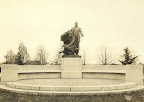
In 1871, COL James T. Murfee was appointed president of Howard College in Marion, a position which he held until Howard moved to Birmingham. From 1887 until his death in 1912, COL Murfee helped to transform Marion Military Institute into one of the premier educational institutions in the South. He also involved himself with the fortunes of Howard College, Judson College, Marion Female Seminary, and the Siloam Baptist Church in Marion. COL Murfee was instrumental in bringing Booker T. Washington to Alabama and Tuskegee Institute, a fact publicly acknowledged by Washington when he spoke to a large gathering in Marion in 1913.
The memorial for Booker T. Washington at Tuskegee Institute, now Tuskegee University, in Alabama. (MMI Archives)

At one time or another, James Thomas Murfee was offered – but, declined – the presidencies of the University of Alabama, and what became Auburn University and the University of Montevallo.
President Benjamin Harrison appointed COL Murfee to the Board of Visitors at the United States Military Academy at West Point. In 1906, Murfee received one of the first annuities established by the Carnegie Foundation for the Advancement of Teaching in recognition of his extraordinary contribution to American education.
COL Murfee was elected in 1997 to the Alabama Men’s Hall of Fame at Samford University in Birmingham. (Image by Bill Mathews)
James Thomas Murfee died in Miami, FL, on April 23, 1912, and is buried with his wife, Laura Owen (died 1920), in the Marion cemetery. (MMI Archives)

COL Murfee was succeeded as president of MMI by his son, Hopson Owen Murfee (1905-1918). Two other Murfees, Walter Lee Murfee (1918-1944) and James Thomas Murfee, II (1944-1953), would serve as the third and fourth presidents of MMI.
The MMI faculty from The Assembly (yearbook) for 1901. (MMI Archives)

Finally, a side bar: As a distinguished graduate of the Virginia Military Institute, Class of 1853, James Murfee was consulted in 1856 by VMI authorities concerning the possible removal of his former professor, Thomas Jonathan (“Stonewall”) Jackson, from teaching in the VMI classroom! Apparently, Jackson’s teaching skills and subject knowledge were lacking. While Murfee supported his former teacher as a man of honor, honesty, integrity, and strong religious conviction (and a heroic Mexican War veteran), he had to confess that he had learned little in Jackson’s class. (VMI Archives)











